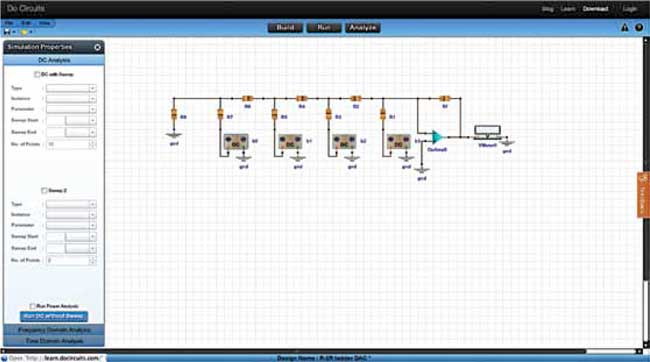Tired of going to the lab everyday to conduct your simulation tests? Well, worry no more! Debabrata Bagchi, CEO and founder, Sparsha Learning Technologies, has devised a very simple Web-based simulation centre for all your simulation problems—DoCircuits. It is a virtual lab that lets you create, analyse and run analogue, digital and mixed-mode electronics circuits, entirely in your browser.
The world of electronic simulation
Electronic circuit simulation uses mathematical models to replicate the behaviour of an actual electronic device or circuit. Simulation software typically allows for modeling of circuit operation and is an invaluable analysis tool. Due to its highly accurate modeling capability, it is widely used for teaching purposes in technical institues.
The software engages the users by integrating them into the learning experience. These kinds of interactions actively engage learners to analyse, synthesise, organise and evaluate content, and result in learners constructing their own knowledge. It is, undoubtedly, imperative that an electronics engineer be well versed in the fine art of simulation.
Simulating a circuit’s behaviour prior to building it greatly improves design efficiency by making faulty designs known as such, and providing insight into the behaviour of circuit designs. In particular, for integrated circuits, the tooling is expensive, breadboards impractical, and probing the behaviour of internal signals extremely difficult. Therefore almost all the IC design relies heavily on simulation. The most well known analogue simulator is SPICE, while on the digital side, simulators based on Verilog and VHDL are the most commonly used.
The need for an online Web-based simulator
As mentioned above, there are plenty of simulator packages already available in the market. But there are several issues with the solutions offered in the simulation domain.
“The software need to be downloaded/installed. These have a steep learning curve—not to mention the need for an expert to be guiding you side-by-side. User-experience isn’t a priority with these software. The biggest trouble is that people who are just starting out in this field are in a position where they have to use high-end simulators. They need to get an in-depth knowledge before beginning the work,” says Bagchi.

“DoCircuits is my way of letting the small guy play with electronics and get to know how fun it is. We wanted to make simulation easy and accessible for all. We wanted to make it more fun, and are looking at gamifying some of the features to make it more appealing to the younger crowd. We will be developing premium solutions for the enterprise market as well,” Bagchi adds.
DoCircuits.com—An overview
DoCircuits is a cloud-based application that took around nine months to develop. Users go to www.DoCircuits.com and create a login. A single login allows them to create innumerable circuits. By clicking ‘Launch Virtual Labs,’ they can save these circuits on the cloud so that they can be accessed from anywhere. This allows the users to share their circuits with others.
When a user creates circuits and runs them on the cloud, results are processed from the cloud and shown to the user for analysis. The cloud backend is implemented over Microsoft Azure, while the front end is created in Flex. You can access the simulation features even without logging in. But to make use of the sharing and saving features, a login is necessary.
To top it all, this cloud-reliant solution is not very bandwidth-intensive as the only data transferred is the circuit and its simulation results. All the other information is in the browser itself. Since the simulation has been implemented on the cloud, there is no restriction on the number of people using it simultaneously.
“Our algorithms will scale up at the back end automatically. Hence you wouldn’t be handicapped by the speed of your connection,” says Bagchi.
Hardships
The simplest ideas are usually the hardest to realise. Bagchi explains the challenges they faced: “The challenges we faced were mainly restricted to R&D—mostly in product design, creating load balancing algorithms on the cloud, creating models for new components, solving mathematical simulation problems for running large circuits, etc. Some of the other problems were related to the look of the final product. We had to go through a lot of changes regarding the features we allowed. We had to remove a few features because they didn’t offer anything functional to the product and were mostly an aesthetic addition. Thankfully, we didn’t face any problem that made us pull out our hair.”
Future plans
Product development and innovation is a continuous process. Bagchi shares the improvements that they plan for the future versions of their solution: “We are adding capabilities for pure digital simulation, supporting integrated circuits, learning and running Verilog and VHDL simulations along with the ability for more devices and components and analysis methods.”
From monetisation to patenting the technology, Bagchi has a pretty comprehensive roadmap planned for Do-Circuits. “We will be targeting global users, students and teachers in the next two years and target to have 100,000 active users using simulation by 2014. Post 2014 we will release our enterprise version for SMBs in the semiconductor space. We also see growth in using this solution for building experimential learning courses in electronics and hope to certify 50,000 students with this platform by 2014. Running the simulation online is currently free. Going ahead, we will introduce simulation as a service model for advanced simulation features and components. We have an offline version of the tool for the PC priced at Rs 1000 for a year’s licence,” Bagchi informs.
“We are currently in the process of patenting some of the technology used for the product. This is the age of cloud computing, cloud storage and so on. This is just the beginning of the cloud revolution,” he sums up.
For reading latest innovation articles: click here
The author is a tech correspondent at EFY Bengaluru








Hola Soy Nuevo en esta canal
Bienvenido a bordo